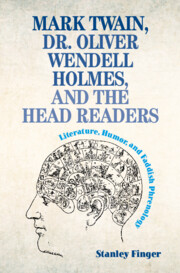 Mark Twain, Dr. Oliver Wendell Holmes, and the Head Readers
Mark Twain, Dr. Oliver Wendell Holmes, and the Head Readers Published online by Cambridge University Press: 17 April 2023
During the 1790s, Franz Joseph Gall, a German now practicing medicine in Vienna, came forth with a new way of thinking about the mind and brain. He envisioned the mind having many specialized functions, each dependent on a different part of the brain for its expression. He had a variety of methods for determining these function–structure relationships but relied most heavily on skull features. Bumps and depressions on specific parts of the skull, he reasoned, reflected the growth of the underlying parts. Hence, by studying the heads and crania of humans and animals, one could find separate organs for music, mathematics, and even color perception. Stated differently, a skilled observer could use craniology for probing the mysteries of the mind and understanding the functional organization of the brain. In 1805, Gall left Vienna with his new assistant, Johan Spurzheim, to present his “organology” in various European centers of learning. He never returned. He settled in Paris in 1807, where he lectured and published his books on his ideas. He died there in 1828, still believing in his new science of man, yet knowing that his skull-based assertions were still the most controversial features of his doctrine.
To save this book to your Kindle, first ensure [email protected] is added to your Approved Personal Document E-mail List under your Personal Document Settings on the Manage Your Content and Devices page of your Amazon account. Then enter the ‘name’ part of your Kindle email address below. Find out more about saving to your Kindle.
Note you can select to save to either the @free.kindle.com or @kindle.com variations. ‘@free.kindle.com’ emails are free but can only be saved to your device when it is connected to wi-fi. ‘@kindle.com’ emails can be delivered even when you are not connected to wi-fi, but note that service fees apply.
Find out more about the Kindle Personal Document Service.
To save content items to your account, please confirm that you agree to abide by our usage policies. If this is the first time you use this feature, you will be asked to authorise Cambridge Core to connect with your account. Find out more about saving content to Dropbox.
To save content items to your account, please confirm that you agree to abide by our usage policies. If this is the first time you use this feature, you will be asked to authorise Cambridge Core to connect with your account. Find out more about saving content to Google Drive.